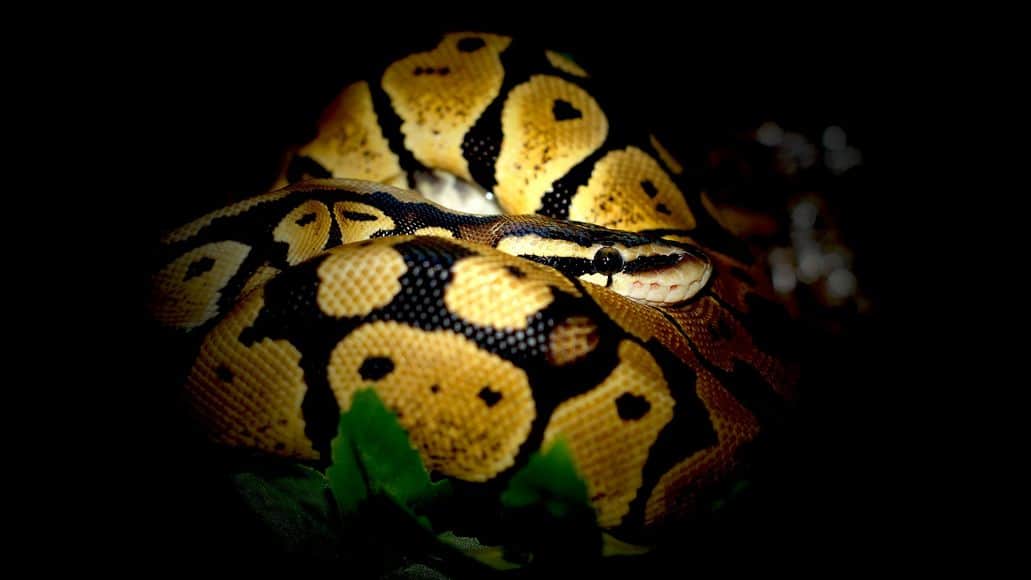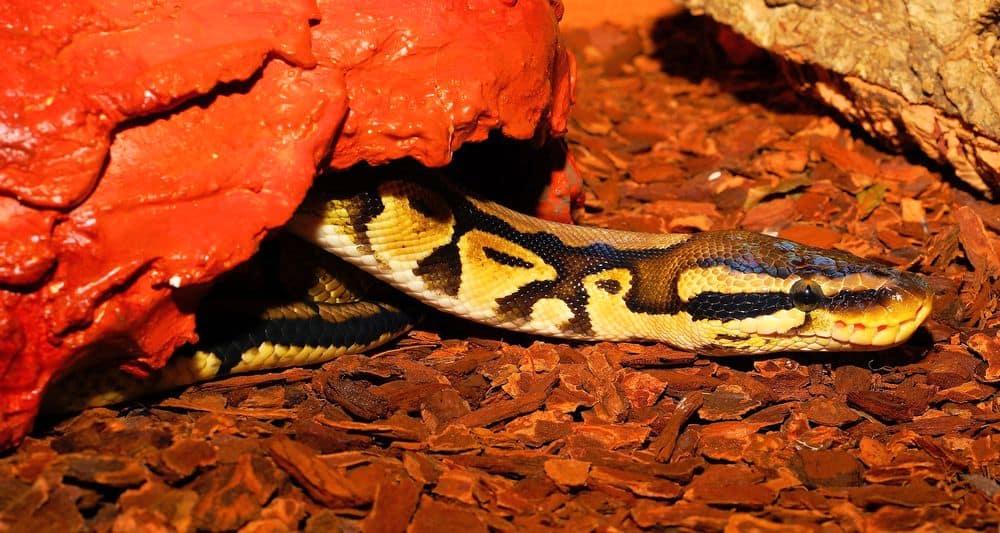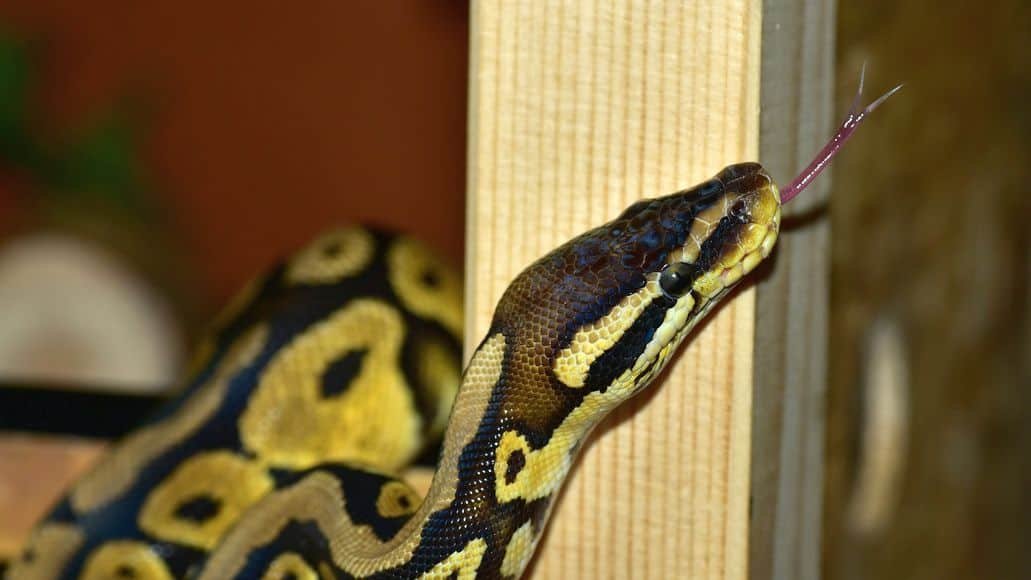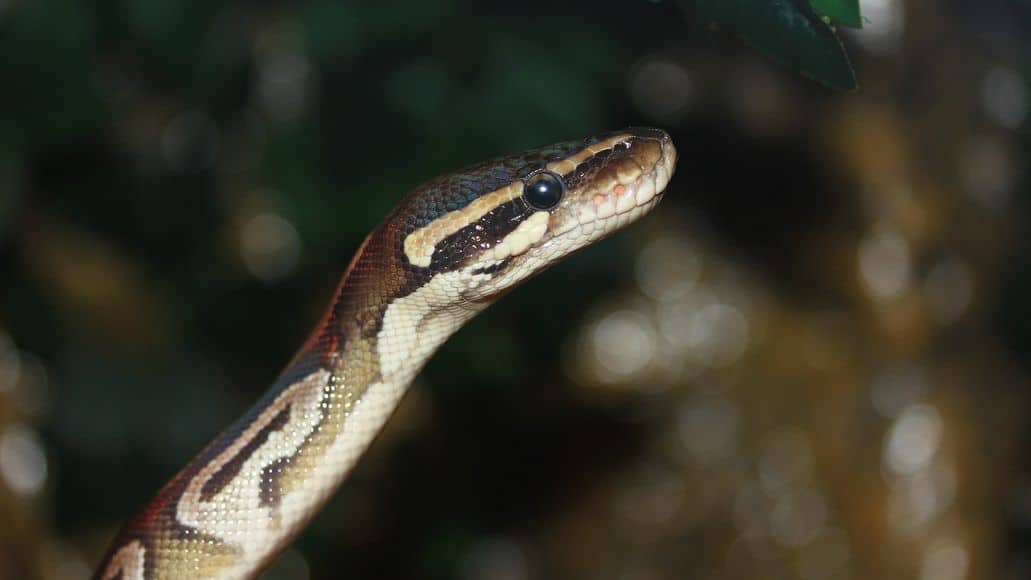
Then the ball python is an excellent choice. It is a small, docile snake that makes for a great pet.
It does not take up much space and is not as sensitive to changes in its environment as some other species. It is also not aggressive and is harmless to humans, as a constrictor.
That said, it will get aggressive if you threaten it or otherwise mistreat it.
And if you get yours from the wild (you should always get a snake that was born in captivity, not in the wild), it will be much more difficult to take care of and likely be more aggressive as well.
If you get a captive-born snake and you provide it an appropriate home and treat it well, your Ball Python will be a lovely pet.
This is one of the best breeds of snake top own. And not just for beginning snake owners, but for expert snake handlers as well. Let’s take a closer look.
Table of Contents
- 1 Do Ball Pythons Make Good Pets?
- 1.1 What Does A Ball Python Look Like?
- 1.2 What Type Of House Does My Ball Python Need?
- 1.3 What Type Of Bedding Does My Ball Python Need?
- 1.4 What Kind Of Lighting For My Ball Python?
- 1.5 What To Feed My Ball Python?
- 1.6 Do Ball Pythons Need Veterinary Care?
- 1.7 Are Ball Pythons Friendly?
- 1.8 Do Male Or Female Ball Pythons Make Better Pets?
- 1.9 Do Ball Pythons Constrict?
- 2 Ball Pythons Making Good Pets: Final Thoughts
Do Ball Pythons Make Good Pets?
In captivity, ball pythons can live up to forty years with the proper care and husbandry. That is far longer than any mammal species kept as pets. The world record for oldest Ball Python is forty-three years, set by a snake living at the Philadelphia Zoo.
As long as you know that the ball python is a long-term commitment, it is a great breed for a beginner to learn all about keeping snakes. It can serve as a stepping stone to a snake that is more difficult to care for. They are a little heartier than most other breeds and do not decline in health as quickly with bad husbandry.
How much is a ball python? Not much, if it is a regular one.This species ranges from $30 to $5000, but most are under $100. It is the rare morphs that cost a lot.
Before you purchase any snake, you should learn everything you can about the snake you’re going to get. That ensures you know what to expect and you know what your snake will need to feel comfortable.
As with any other exotic animal: the younger you start handling them the more social they will become. It is best to purchase a ball python hatched in captivity, versus one caught in the wild. Captive-born ball pythons are easier to tame and to train to accept human handling.
What Does A Ball Python Look Like?
The ball python gets its name from a distinctive behavior when it gets scared. When frightened, it will roll into a ball with its head tucked in the middle.

There are an extensive variety of color, patterns, and markings. These variations are called morphs. The most common morphs of Ball Pythons include Albino, Hypomelanistic, Axanthic, Piebald, Banana and Clown.
There are many other morphs. Albino Ball Pythons lack color pigmentation which causes the snake to be yellow with red eyes. Hypomelanistic Ball Pythons, also called Ghost, are very light in one particular shade of color. Axanthic Ball Pythons are usually white, grey and black and lack the yellow pigment.
Piebald Ball Pythons have patches of white and black. Clown Ball Pythons have a very distinct golden, yellow appearance. They have a dark marking on their head and a stripe down the entire length of the snake.
What Type Of House Does My Ball Python Need?
The right environment and temperature are key to keeping a healthy ball python. When you first bring your ball python home, do not handle it for about a week to allow it to adjust to its new surroundings. Ball pythons need an enclosure that provides adequate room to grow.
It should have a sturdy lid with a latch that can be locked shut. This species, in particular, are very curious animals and often escape from their enclosure and become lost in your house. There are all kinds of stories about pythons getting stuck behind walls, in furniture, and even in the plumbing of an apartment building.
As adults they grow to be three to four feet long, so they will need an appropriately sized enclosure. A favorite structure among snake enthusiast for housing ball pythons is in a terrarium. This article helps you set one up.
Large glass terrariums come in a multitude of sizes and are typically sold locally. That said, you can get some great ones on Amazon too. This article reviews the best ball python terrariums.
Some prefer to build their own enclosure out of wood. This can work, but wood does present some problems. It is harder to clean and can become moldy, given the high humidity your snake needs.
Ball pythons require a warm environment. Terrariums are easy to outfit with all the necessary lighting, heat sources and humidifier that a python may need.
What Type Of Bedding Does My Ball Python Need?

It is best to cover the bottom of the enclosure with a substrate that is specialized for reptiles such as cypress mulch, orchid bark, or coconut husk. Avoid pine shavings, sand or paper. Learn about the best snake bedding for ball pythons.
When snakes eat, they can accidentally ingest some of their substrate, so it is important to choose something that won’t cause an impaction.
Avoid cedar shaving or any strong-smelling substrate as these can cause upper respiratory problems. A good rule to have is to smell the bedding and see if you would want that smell an inch from your nose at all times.
What Kind Of Lighting For My Ball Python?
The main thing you need is a good heat bulb. Ideally, it should hang over the cage, outside of the lid, so your snake can’t burn itself.
So people prefer heat rocks, but they can cause bad burns to the snake, so we do not recommended using those. Snakes tend to lay on top of them for too long, resulting in serious, and sometimes life-threatening, burns.
The temperature inside the cage should stay between 80 and 85° Fahrenheit. Ball pythons can not last long without heat.
Heat lamps can either be a white light bulb with a thick filament that emits heat directly to a specific area or an an infrared bulb that emits heat more gradually outward.
Ceramic bulbs are another way to heat a bigger area, and they work well at night because they do not emit any light. Most cages have a variety of different bulbs in order to keep the cage at its ideal temperature all day.
The ball python does not require UVB light, but it increases your snake’s activity level and helps brighten its color. UVB is light in the invisible part of the color spectrum. The sun emits UVB (it’s what gives us a tan), but you can also get bulbs that emit it.
This particular spectrum of light fades after about 6 months. It is advised to change your UVB bulbs every 6 months, whether the light has gone out or not. The bulb will still glow, but it will no longer emit any UVB wavelengths.
Again, pythons do not need UVB, but if you are going to use it, be aware how long it will last and when it needs to be changed. The label should tell you. Most manufacturers will have some sort of graph showing the light spectrum of the bulb and how long it lasts until the different wavelengths fade.
What To Feed My Ball Python?

Young ball pythons should eat baby mice and rats (pinkies, fuzzies or hoppers). You can also feed other meat. Ball pythons can even eat fish, though they definitely prefer rodents. Feed younger snakes every week and adult snakes every other week.
As your ball python grows, so should the size of the mouse or rat. It is recommended that the size of the mouse equal the circumference of the snake at its largest point.
Most snakes, if started off young, will eat pre-killed or frozen mice. Thaw the mouse at room temperature before feeding. Do not use a microwave to thaw out frozen mice.
If your snake will not eat pre-killed or frozen animals, you can feed it live mice. Live mice simulate their natural environment and allow them to “hunt” their prey.
Never leave a live mouse or rat in the cage unattended with your snake, because the mouse or rat could injure it. Most ball pythons like to eat at night. They use the heat pit located on their upper jaw to find and attack their prey.
After feeding your ball python, it is important not to handle it for a few hours, because this may cause it to regurgitate its food. This article covers how often a ball python eats.
Ball pythons also need a supply of fresh water daily. Make sure that their water bowl is heavy, so that your python cannot flip it over. It also needs to be deep enough for your snake to curl up in, but not deep enough that it could drown.
Most snakes will soak more around shedding time to help the scales shed properly. If they do not shed properly and you have a ball python stuck shed on your hands, water is also one way to help complete the shedding process.
During the winter, ball pythons may hibernate and not eat as regularly. Continue offering them food every ten to fourteen days until they return to their normal eating schedule. They will also not eat during a shed.
Do Ball Pythons Need Veterinary Care?
Ball pythons do need regular checkups by an exotic veterinarian. When you first get your snake get it an initial checkup as soon as possible. Not all breeders practice good husbandry, so you should make sure you are not bringing any diseases into the enclosure.
Before purchasing your python locate a veterinarian near you who can treat and examine your snake. Most snakes will have some problem or illness over the course of their lifetime and will need veterinary care.
Common health problems seen with snakes are upper respiratory infections, burns or cuts on the skin, abscesses in their mouth or problems with shedding.
If you notice any of these problems, take your snake to your veterinarian right away. Most exotic species do not show that they are sick until it may already be too late to correct the problem, so you should learn to recognize the signs that your snake is sick.
Ball pythons can get parasites from the mice and rats that they eat. Most veterinarians recommend routine fecal examinations to help keep your pet free of parasites.
Are Ball Pythons Friendly?

Ball pythons are very friendly and enjoy people handling them for a few minutes every day. They won’t ever recognize you and react to you the same way a dog might, but they will come to know who you are.
You should handle your ball python daily so that your snake is used to being touched. This also allows you to examine your snake for any scratches, bruises or other health related problems.
Keep in mind that ball pythons tend to be very head-shy, meaning they do not like to have their head touched. Continuing to do so might elicit an aggressive response. It doesn’t mean they are aggressive. It simply means they do not like being touched there, so it is best to just avoid the area altogether.
Overall, ball pythons are one of the friendlier snakes and are more accepting of being handled. This puts them in stark contrast to many other species, like the blood python. See our detailed comparison of the ball python and blood python for more.
Do Male Or Female Ball Pythons Make Better Pets?
Both male and female ball pythons make great pets. Some people prefer the males as they are a little smaller than the females. As far as temperament goes there really is no difference between the two.
Females usually cost more since they are able to reproduce. Snake breeders like to have more females than males because a single male can breed several females in a short period of time.
If you do breed, make sure to only leave the snakes together for mating. Do not house two ball pythons together permanently. It will not go well. And read this article on how to breed ball pythons.
Do Ball Pythons Constrict?
Ball pythons are a type of constrictor snake. This means that they wrap their body around their prey and squeeze it until it suffocates. But they are not a type of boa constrictor. That is a different family of snakes. See our article on the difference between boas and pythons for more.
Most python owners notice that their snake will wrap itself around their arm. This doesn’t necessarily mean they are trying to suffocate or kill you.
Ball pythons are jungle snakes and are very comfortable in the treetops. They may just view your arm as a branch from which to hang. It is usually quite easy to remove them if you start to feel uncomfortable.
If a python doesn’t easily let go, don’t panic. A bit of cool water will loosen them up.
Just a little though. Too much can drop the snake’s body temperature too quickly and have adverse effects. Remember, snakes regulate their body temperature with heat and light, so they react quickly to external temperature changes.
Ball Pythons Making Good Pets: Final Thoughts
For a beginner, caring for your ball python might seem challenging at first, but this is one of the easiest breeds of snakes to keep in captivity. Handling and feeding your snake will help strengthen your bond with it. They more it trusts you, the more it will respond to you handling it.
With a little time and planning, you will soon see just how easy it is to care for a snake, especially a ball python. They make wonderful pets for beginners and experts alike.
Levi Armstrong says
It’s great that you said that a ball python is a great choice for a snake pet because it is easy to tame and to train. However, you must buy one born and raised in captivity. I’ve always wanted to have a pet snake since I was a child but my parents were firm against getting one. Hopefully, my boyfriend will agree to us getting a ball python so I can finally have my dream pet. Thanks for this!